The Influence of Reword on Employee Motivation
VerifiedAdded on 2023/06/13
|16
|4493
|421
AI Summary
This research proposal aims to establish the relationship between extrinsic and intrinsic rewards and employee motivation. It explores the reasons for the variation in employee performance in different organizations and attempts to offer possible solutions to increase employee motivation. The study investigates the impact of rewards on employee motivation and performance, employees’ views of rewards, and managers’ attitudes towards rewards and employee motivation. The study uses quantitative, non-experimental descriptive co-relational and cross-sectional methods to collect and analyze data. The findings will be of relevance to business organizations, government authorities, and students in universities.
Contribute Materials
Your contribution can guide someone’s learning journey. Share your
documents today.
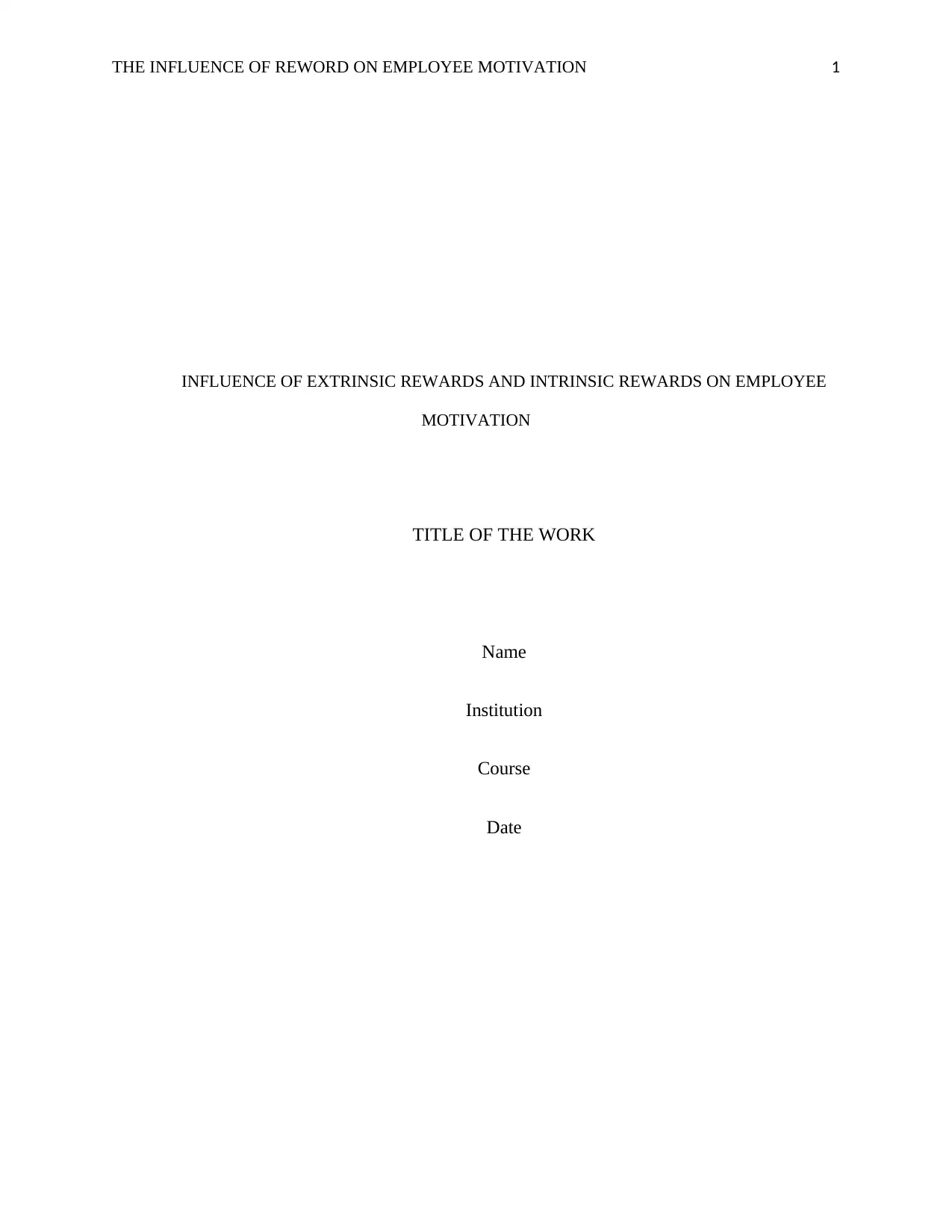
THE INFLUENCE OF REWORD ON EMPLOYEE MOTIVATION 1
INFLUENCE OF EXTRINSIC REWARDS AND INTRINSIC REWARDS ON EMPLOYEE
MOTIVATION
TITLE OF THE WORK
Name
Institution
Course
Date
INFLUENCE OF EXTRINSIC REWARDS AND INTRINSIC REWARDS ON EMPLOYEE
MOTIVATION
TITLE OF THE WORK
Name
Institution
Course
Date
Secure Best Marks with AI Grader
Need help grading? Try our AI Grader for instant feedback on your assignments.
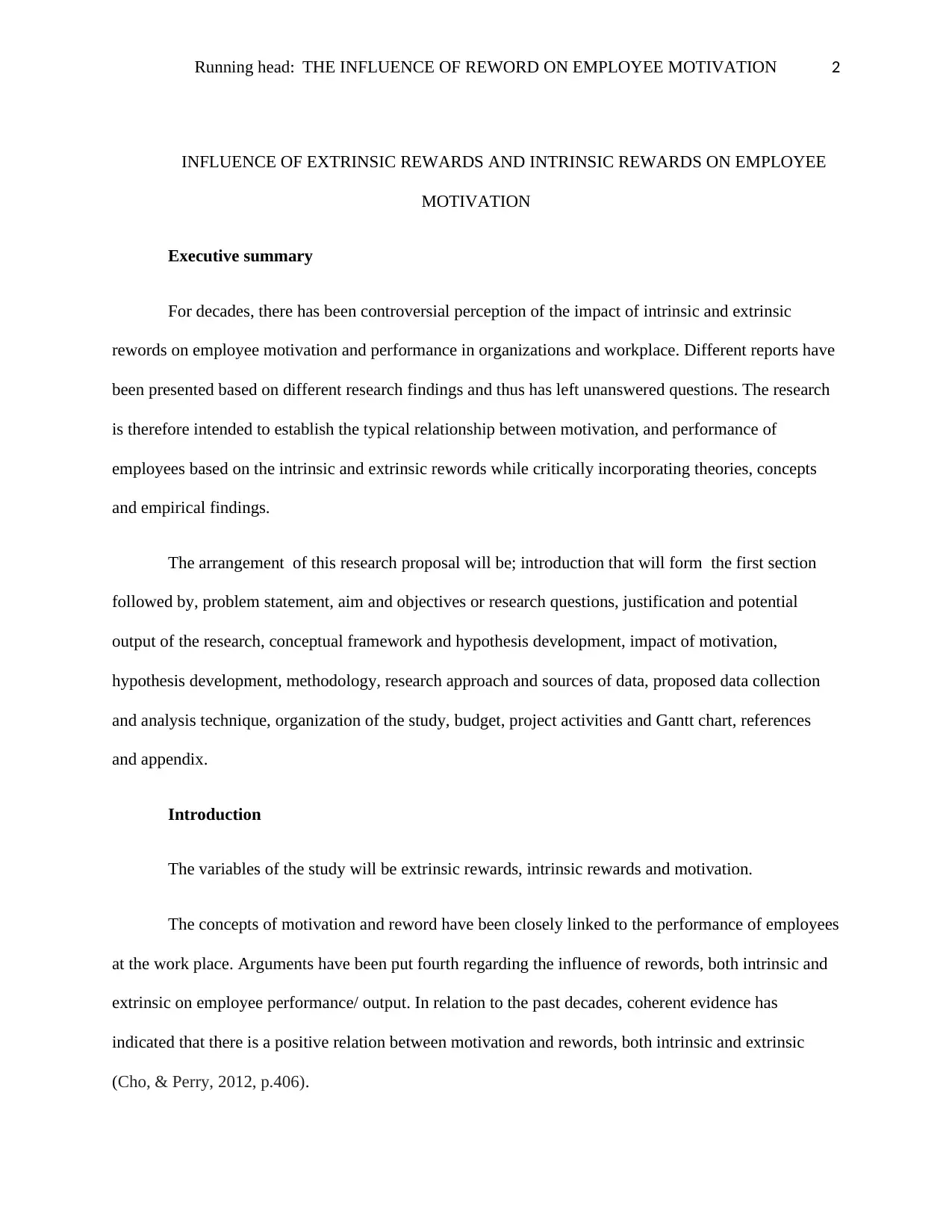
Running head: THE INFLUENCE OF REWORD ON EMPLOYEE MOTIVATION 2
INFLUENCE OF EXTRINSIC REWARDS AND INTRINSIC REWARDS ON EMPLOYEE
MOTIVATION
Executive summary
For decades, there has been controversial perception of the impact of intrinsic and extrinsic
rewords on employee motivation and performance in organizations and workplace. Different reports have
been presented based on different research findings and thus has left unanswered questions. The research
is therefore intended to establish the typical relationship between motivation, and performance of
employees based on the intrinsic and extrinsic rewords while critically incorporating theories, concepts
and empirical findings.
The arrangement of this research proposal will be; introduction that will form the first section
followed by, problem statement, aim and objectives or research questions, justification and potential
output of the research, conceptual framework and hypothesis development, impact of motivation,
hypothesis development, methodology, research approach and sources of data, proposed data collection
and analysis technique, organization of the study, budget, project activities and Gantt chart, references
and appendix.
Introduction
The variables of the study will be extrinsic rewards, intrinsic rewards and motivation.
The concepts of motivation and reword have been closely linked to the performance of employees
at the work place. Arguments have been put fourth regarding the influence of rewords, both intrinsic and
extrinsic on employee performance/ output. In relation to the past decades, coherent evidence has
indicated that there is a positive relation between motivation and rewords, both intrinsic and extrinsic
(Cho, & Perry, 2012, p.406).
INFLUENCE OF EXTRINSIC REWARDS AND INTRINSIC REWARDS ON EMPLOYEE
MOTIVATION
Executive summary
For decades, there has been controversial perception of the impact of intrinsic and extrinsic
rewords on employee motivation and performance in organizations and workplace. Different reports have
been presented based on different research findings and thus has left unanswered questions. The research
is therefore intended to establish the typical relationship between motivation, and performance of
employees based on the intrinsic and extrinsic rewords while critically incorporating theories, concepts
and empirical findings.
The arrangement of this research proposal will be; introduction that will form the first section
followed by, problem statement, aim and objectives or research questions, justification and potential
output of the research, conceptual framework and hypothesis development, impact of motivation,
hypothesis development, methodology, research approach and sources of data, proposed data collection
and analysis technique, organization of the study, budget, project activities and Gantt chart, references
and appendix.
Introduction
The variables of the study will be extrinsic rewards, intrinsic rewards and motivation.
The concepts of motivation and reword have been closely linked to the performance of employees
at the work place. Arguments have been put fourth regarding the influence of rewords, both intrinsic and
extrinsic on employee performance/ output. In relation to the past decades, coherent evidence has
indicated that there is a positive relation between motivation and rewords, both intrinsic and extrinsic
(Cho, & Perry, 2012, p.406).
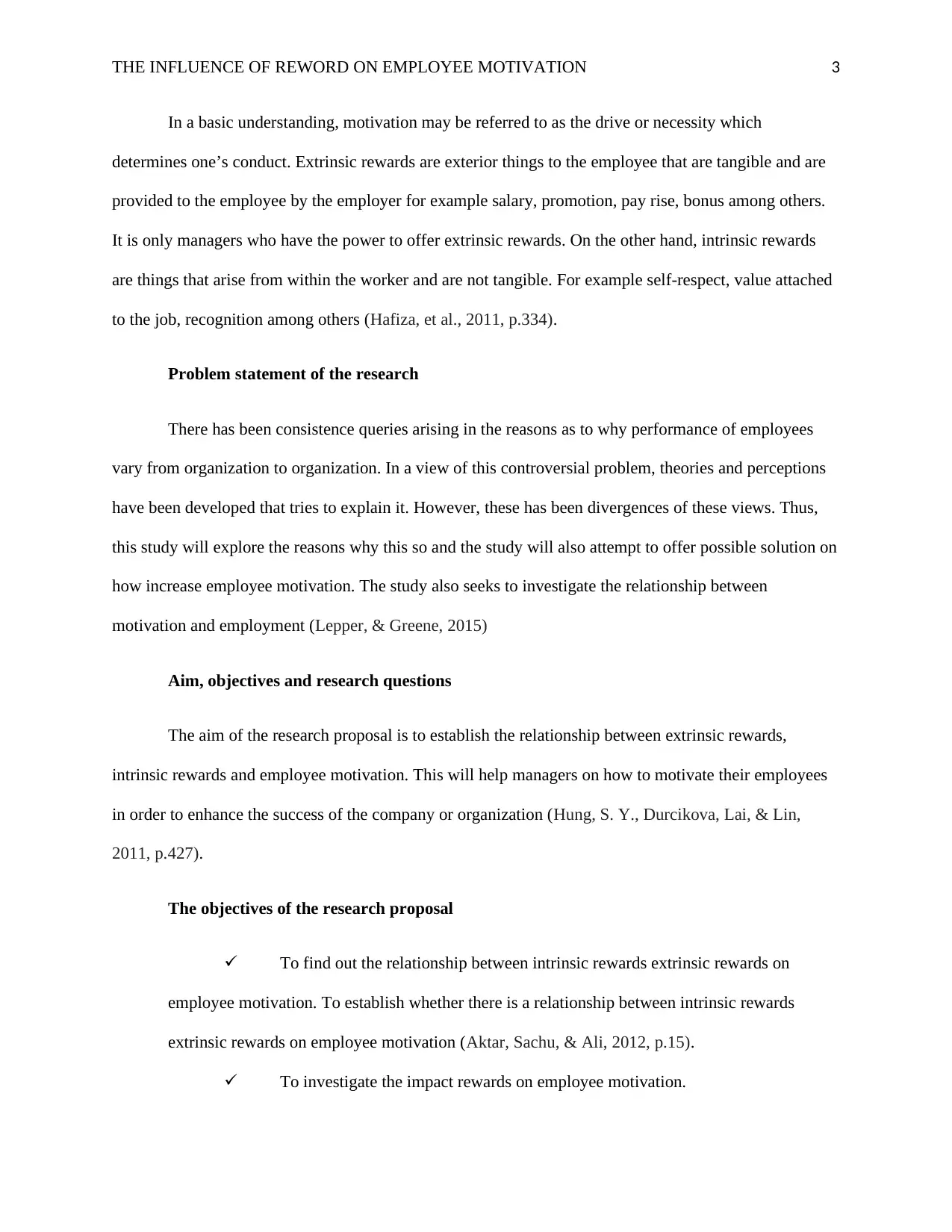
THE INFLUENCE OF REWORD ON EMPLOYEE MOTIVATION 3
In a basic understanding, motivation may be referred to as the drive or necessity which
determines one’s conduct. Extrinsic rewards are exterior things to the employee that are tangible and are
provided to the employee by the employer for example salary, promotion, pay rise, bonus among others.
It is only managers who have the power to offer extrinsic rewards. On the other hand, intrinsic rewards
are things that arise from within the worker and are not tangible. For example self-respect, value attached
to the job, recognition among others (Hafiza, et al., 2011, p.334).
Problem statement of the research
There has been consistence queries arising in the reasons as to why performance of employees
vary from organization to organization. In a view of this controversial problem, theories and perceptions
have been developed that tries to explain it. However, these has been divergences of these views. Thus,
this study will explore the reasons why this so and the study will also attempt to offer possible solution on
how increase employee motivation. The study also seeks to investigate the relationship between
motivation and employment (Lepper, & Greene, 2015)
Aim, objectives and research questions
The aim of the research proposal is to establish the relationship between extrinsic rewards,
intrinsic rewards and employee motivation. This will help managers on how to motivate their employees
in order to enhance the success of the company or organization (Hung, S. Y., Durcikova, Lai, & Lin,
2011, p.427).
The objectives of the research proposal
To find out the relationship between intrinsic rewards extrinsic rewards on
employee motivation. To establish whether there is a relationship between intrinsic rewards
extrinsic rewards on employee motivation (Aktar, Sachu, & Ali, 2012, p.15).
To investigate the impact rewards on employee motivation.
In a basic understanding, motivation may be referred to as the drive or necessity which
determines one’s conduct. Extrinsic rewards are exterior things to the employee that are tangible and are
provided to the employee by the employer for example salary, promotion, pay rise, bonus among others.
It is only managers who have the power to offer extrinsic rewards. On the other hand, intrinsic rewards
are things that arise from within the worker and are not tangible. For example self-respect, value attached
to the job, recognition among others (Hafiza, et al., 2011, p.334).
Problem statement of the research
There has been consistence queries arising in the reasons as to why performance of employees
vary from organization to organization. In a view of this controversial problem, theories and perceptions
have been developed that tries to explain it. However, these has been divergences of these views. Thus,
this study will explore the reasons why this so and the study will also attempt to offer possible solution on
how increase employee motivation. The study also seeks to investigate the relationship between
motivation and employment (Lepper, & Greene, 2015)
Aim, objectives and research questions
The aim of the research proposal is to establish the relationship between extrinsic rewards,
intrinsic rewards and employee motivation. This will help managers on how to motivate their employees
in order to enhance the success of the company or organization (Hung, S. Y., Durcikova, Lai, & Lin,
2011, p.427).
The objectives of the research proposal
To find out the relationship between intrinsic rewards extrinsic rewards on
employee motivation. To establish whether there is a relationship between intrinsic rewards
extrinsic rewards on employee motivation (Aktar, Sachu, & Ali, 2012, p.15).
To investigate the impact rewards on employee motivation.
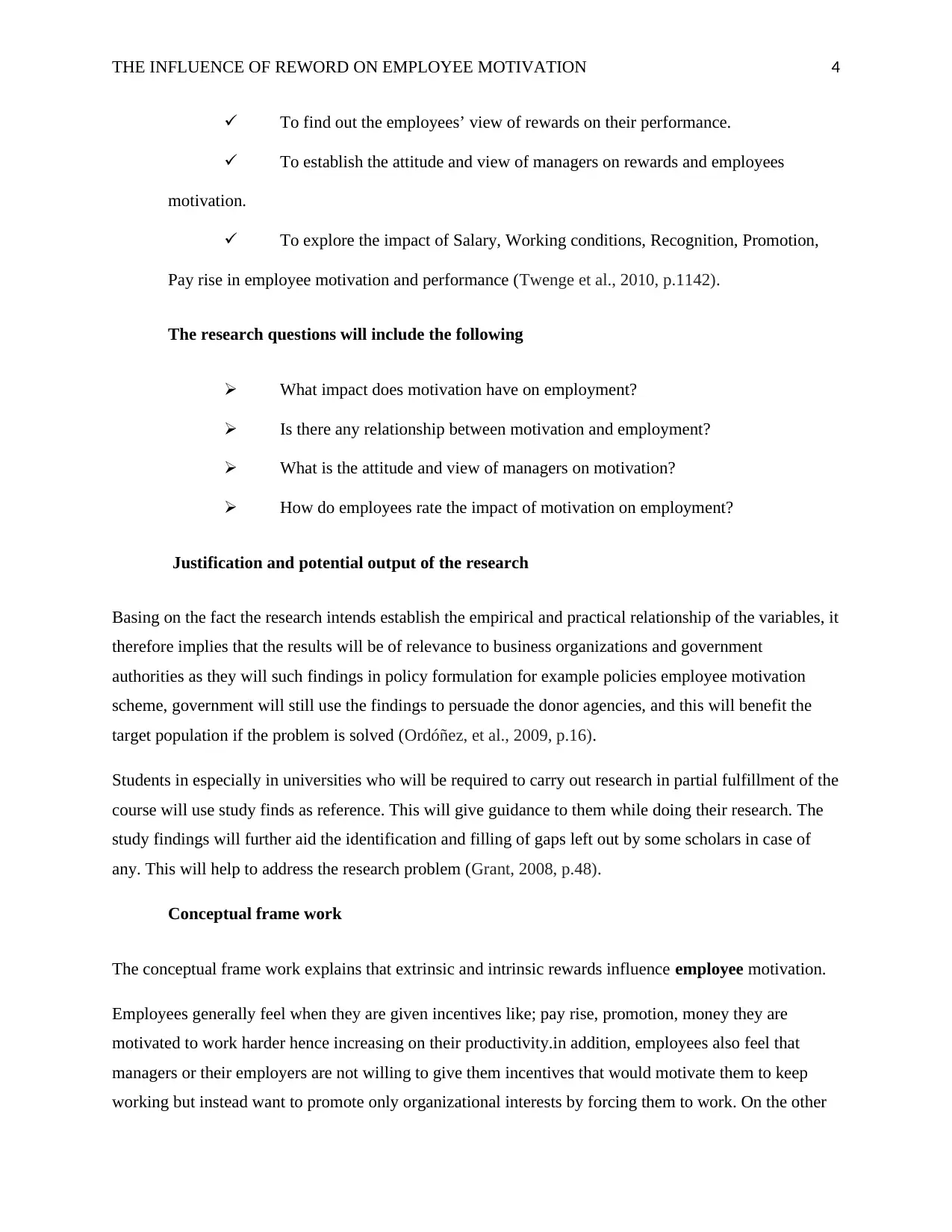
THE INFLUENCE OF REWORD ON EMPLOYEE MOTIVATION 4
To find out the employees’ view of rewards on their performance.
To establish the attitude and view of managers on rewards and employees
motivation.
To explore the impact of Salary, Working conditions, Recognition, Promotion,
Pay rise in employee motivation and performance (Twenge et al., 2010, p.1142).
The research questions will include the following
What impact does motivation have on employment?
Is there any relationship between motivation and employment?
What is the attitude and view of managers on motivation?
How do employees rate the impact of motivation on employment?
Justification and potential output of the research
Basing on the fact the research intends establish the empirical and practical relationship of the variables, it
therefore implies that the results will be of relevance to business organizations and government
authorities as they will such findings in policy formulation for example policies employee motivation
scheme, government will still use the findings to persuade the donor agencies, and this will benefit the
target population if the problem is solved (Ordóñez, et al., 2009, p.16).
Students in especially in universities who will be required to carry out research in partial fulfillment of the
course will use study finds as reference. This will give guidance to them while doing their research. The
study findings will further aid the identification and filling of gaps left out by some scholars in case of
any. This will help to address the research problem (Grant, 2008, p.48).
Conceptual frame work
The conceptual frame work explains that extrinsic and intrinsic rewards influence employee motivation.
Employees generally feel when they are given incentives like; pay rise, promotion, money they are
motivated to work harder hence increasing on their productivity.in addition, employees also feel that
managers or their employers are not willing to give them incentives that would motivate them to keep
working but instead want to promote only organizational interests by forcing them to work. On the other
To find out the employees’ view of rewards on their performance.
To establish the attitude and view of managers on rewards and employees
motivation.
To explore the impact of Salary, Working conditions, Recognition, Promotion,
Pay rise in employee motivation and performance (Twenge et al., 2010, p.1142).
The research questions will include the following
What impact does motivation have on employment?
Is there any relationship between motivation and employment?
What is the attitude and view of managers on motivation?
How do employees rate the impact of motivation on employment?
Justification and potential output of the research
Basing on the fact the research intends establish the empirical and practical relationship of the variables, it
therefore implies that the results will be of relevance to business organizations and government
authorities as they will such findings in policy formulation for example policies employee motivation
scheme, government will still use the findings to persuade the donor agencies, and this will benefit the
target population if the problem is solved (Ordóñez, et al., 2009, p.16).
Students in especially in universities who will be required to carry out research in partial fulfillment of the
course will use study finds as reference. This will give guidance to them while doing their research. The
study findings will further aid the identification and filling of gaps left out by some scholars in case of
any. This will help to address the research problem (Grant, 2008, p.48).
Conceptual frame work
The conceptual frame work explains that extrinsic and intrinsic rewards influence employee motivation.
Employees generally feel when they are given incentives like; pay rise, promotion, money they are
motivated to work harder hence increasing on their productivity.in addition, employees also feel that
managers or their employers are not willing to give them incentives that would motivate them to keep
working but instead want to promote only organizational interests by forcing them to work. On the other
Secure Best Marks with AI Grader
Need help grading? Try our AI Grader for instant feedback on your assignments.
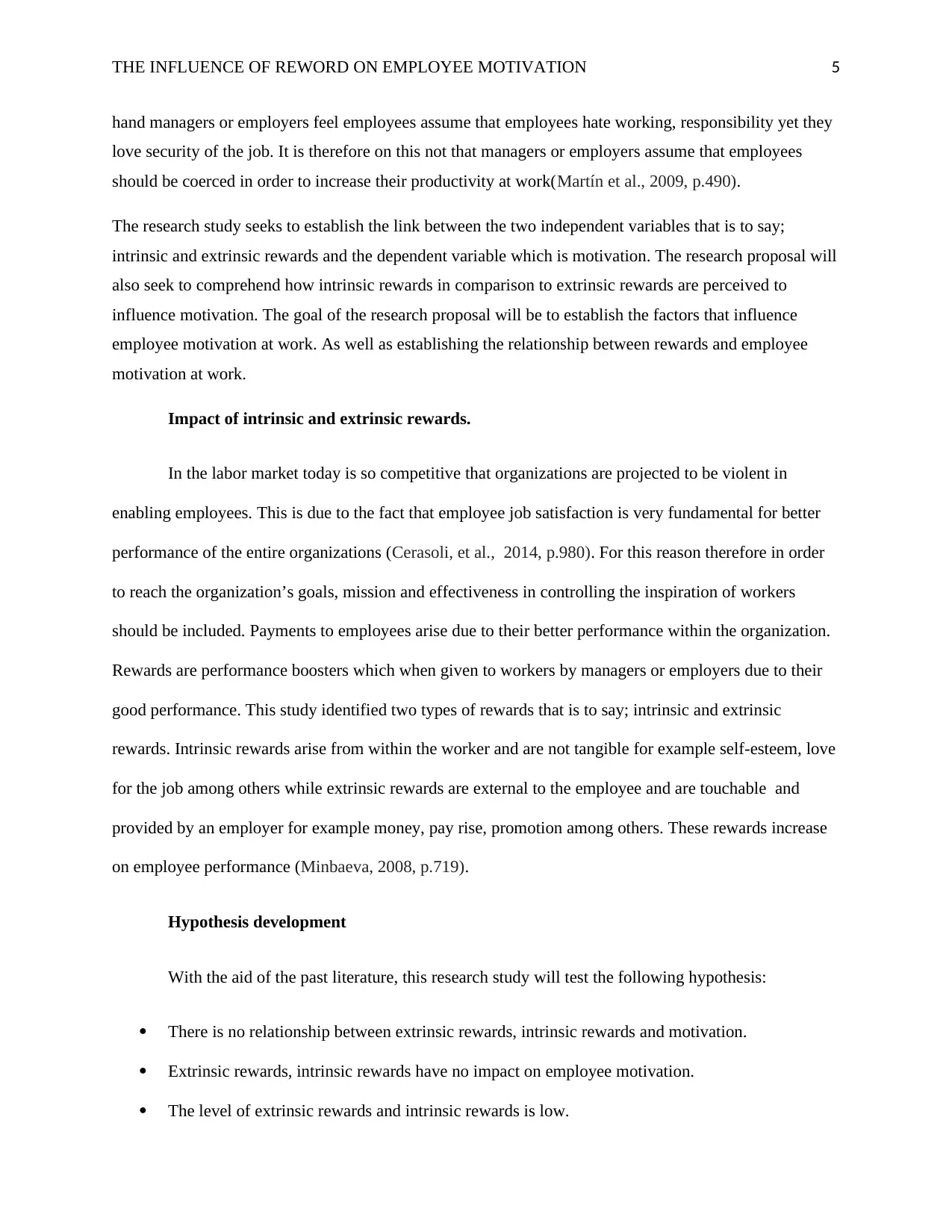
THE INFLUENCE OF REWORD ON EMPLOYEE MOTIVATION 5
hand managers or employers feel employees assume that employees hate working, responsibility yet they
love security of the job. It is therefore on this not that managers or employers assume that employees
should be coerced in order to increase their productivity at work(Martín et al., 2009, p.490).
The research study seeks to establish the link between the two independent variables that is to say;
intrinsic and extrinsic rewards and the dependent variable which is motivation. The research proposal will
also seek to comprehend how intrinsic rewards in comparison to extrinsic rewards are perceived to
influence motivation. The goal of the research proposal will be to establish the factors that influence
employee motivation at work. As well as establishing the relationship between rewards and employee
motivation at work.
Impact of intrinsic and extrinsic rewards.
In the labor market today is so competitive that organizations are projected to be violent in
enabling employees. This is due to the fact that employee job satisfaction is very fundamental for better
performance of the entire organizations (Cerasoli, et al., 2014, p.980). For this reason therefore in order
to reach the organization’s goals, mission and effectiveness in controlling the inspiration of workers
should be included. Payments to employees arise due to their better performance within the organization.
Rewards are performance boosters which when given to workers by managers or employers due to their
good performance. This study identified two types of rewards that is to say; intrinsic and extrinsic
rewards. Intrinsic rewards arise from within the worker and are not tangible for example self-esteem, love
for the job among others while extrinsic rewards are external to the employee and are touchable and
provided by an employer for example money, pay rise, promotion among others. These rewards increase
on employee performance (Minbaeva, 2008, p.719).
Hypothesis development
With the aid of the past literature, this research study will test the following hypothesis:
There is no relationship between extrinsic rewards, intrinsic rewards and motivation.
Extrinsic rewards, intrinsic rewards have no impact on employee motivation.
The level of extrinsic rewards and intrinsic rewards is low.
hand managers or employers feel employees assume that employees hate working, responsibility yet they
love security of the job. It is therefore on this not that managers or employers assume that employees
should be coerced in order to increase their productivity at work(Martín et al., 2009, p.490).
The research study seeks to establish the link between the two independent variables that is to say;
intrinsic and extrinsic rewards and the dependent variable which is motivation. The research proposal will
also seek to comprehend how intrinsic rewards in comparison to extrinsic rewards are perceived to
influence motivation. The goal of the research proposal will be to establish the factors that influence
employee motivation at work. As well as establishing the relationship between rewards and employee
motivation at work.
Impact of intrinsic and extrinsic rewards.
In the labor market today is so competitive that organizations are projected to be violent in
enabling employees. This is due to the fact that employee job satisfaction is very fundamental for better
performance of the entire organizations (Cerasoli, et al., 2014, p.980). For this reason therefore in order
to reach the organization’s goals, mission and effectiveness in controlling the inspiration of workers
should be included. Payments to employees arise due to their better performance within the organization.
Rewards are performance boosters which when given to workers by managers or employers due to their
good performance. This study identified two types of rewards that is to say; intrinsic and extrinsic
rewards. Intrinsic rewards arise from within the worker and are not tangible for example self-esteem, love
for the job among others while extrinsic rewards are external to the employee and are touchable and
provided by an employer for example money, pay rise, promotion among others. These rewards increase
on employee performance (Minbaeva, 2008, p.719).
Hypothesis development
With the aid of the past literature, this research study will test the following hypothesis:
There is no relationship between extrinsic rewards, intrinsic rewards and motivation.
Extrinsic rewards, intrinsic rewards have no impact on employee motivation.
The level of extrinsic rewards and intrinsic rewards is low.
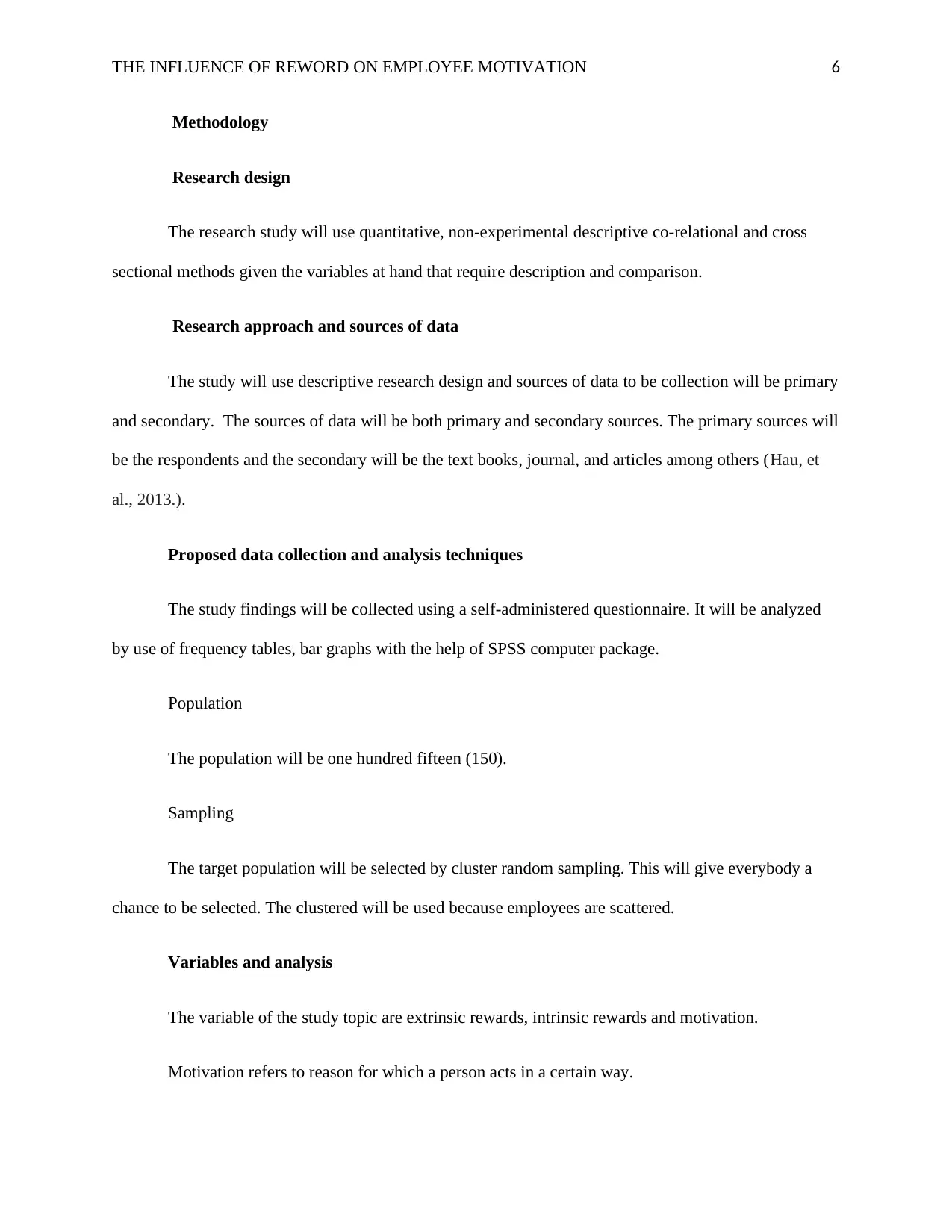
THE INFLUENCE OF REWORD ON EMPLOYEE MOTIVATION 6
Methodology
Research design
The research study will use quantitative, non-experimental descriptive co-relational and cross
sectional methods given the variables at hand that require description and comparison.
Research approach and sources of data
The study will use descriptive research design and sources of data to be collection will be primary
and secondary. The sources of data will be both primary and secondary sources. The primary sources will
be the respondents and the secondary will be the text books, journal, and articles among others (Hau, et
al., 2013.).
Proposed data collection and analysis techniques
The study findings will be collected using a self-administered questionnaire. It will be analyzed
by use of frequency tables, bar graphs with the help of SPSS computer package.
Population
The population will be one hundred fifteen (150).
Sampling
The target population will be selected by cluster random sampling. This will give everybody a
chance to be selected. The clustered will be used because employees are scattered.
Variables and analysis
The variable of the study topic are extrinsic rewards, intrinsic rewards and motivation.
Motivation refers to reason for which a person acts in a certain way.
Methodology
Research design
The research study will use quantitative, non-experimental descriptive co-relational and cross
sectional methods given the variables at hand that require description and comparison.
Research approach and sources of data
The study will use descriptive research design and sources of data to be collection will be primary
and secondary. The sources of data will be both primary and secondary sources. The primary sources will
be the respondents and the secondary will be the text books, journal, and articles among others (Hau, et
al., 2013.).
Proposed data collection and analysis techniques
The study findings will be collected using a self-administered questionnaire. It will be analyzed
by use of frequency tables, bar graphs with the help of SPSS computer package.
Population
The population will be one hundred fifteen (150).
Sampling
The target population will be selected by cluster random sampling. This will give everybody a
chance to be selected. The clustered will be used because employees are scattered.
Variables and analysis
The variable of the study topic are extrinsic rewards, intrinsic rewards and motivation.
Motivation refers to reason for which a person acts in a certain way.
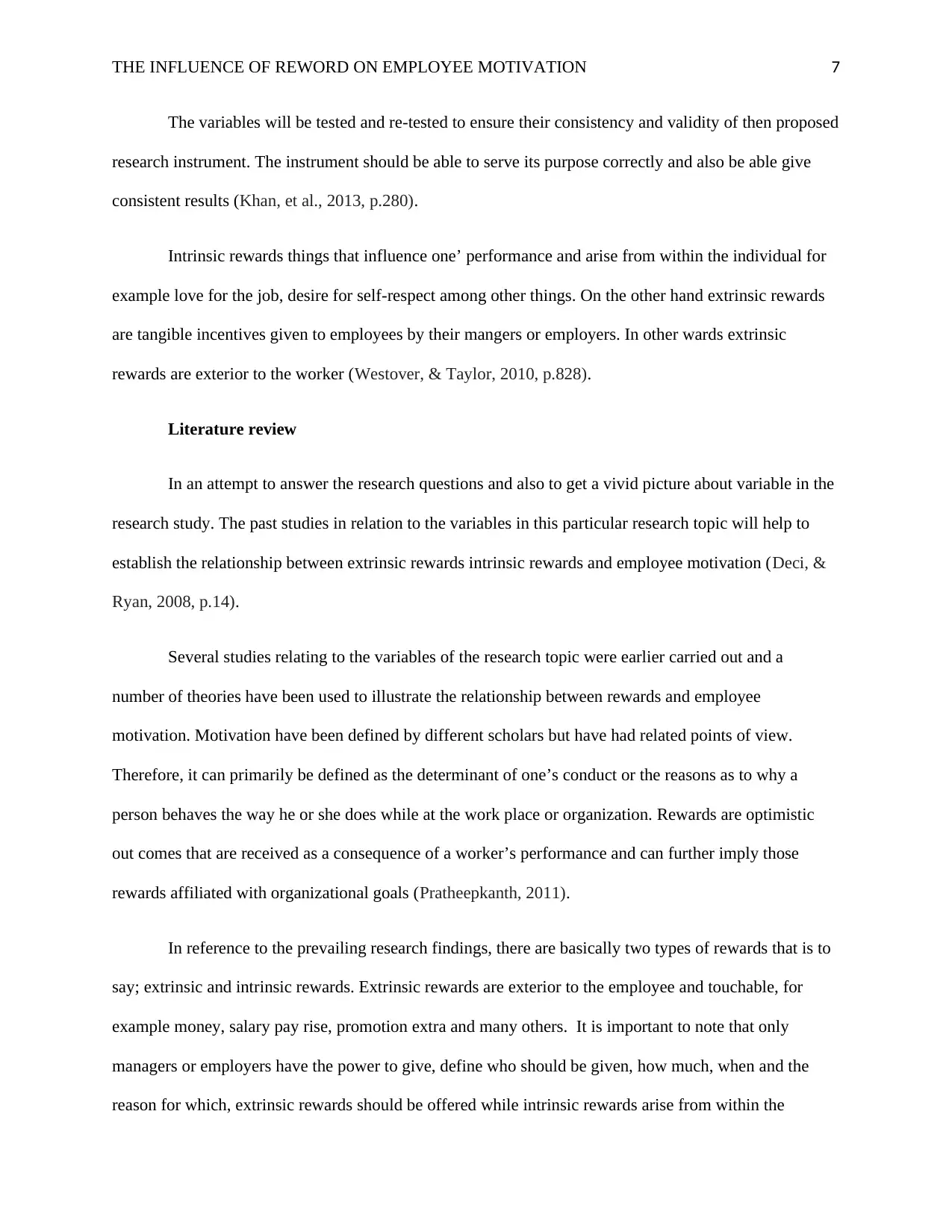
THE INFLUENCE OF REWORD ON EMPLOYEE MOTIVATION 7
The variables will be tested and re-tested to ensure their consistency and validity of then proposed
research instrument. The instrument should be able to serve its purpose correctly and also be able give
consistent results (Khan, et al., 2013, p.280).
Intrinsic rewards things that influence one’ performance and arise from within the individual for
example love for the job, desire for self-respect among other things. On the other hand extrinsic rewards
are tangible incentives given to employees by their mangers or employers. In other wards extrinsic
rewards are exterior to the worker (Westover, & Taylor, 2010, p.828).
Literature review
In an attempt to answer the research questions and also to get a vivid picture about variable in the
research study. The past studies in relation to the variables in this particular research topic will help to
establish the relationship between extrinsic rewards intrinsic rewards and employee motivation (Deci, &
Ryan, 2008, p.14).
Several studies relating to the variables of the research topic were earlier carried out and a
number of theories have been used to illustrate the relationship between rewards and employee
motivation. Motivation have been defined by different scholars but have had related points of view.
Therefore, it can primarily be defined as the determinant of one’s conduct or the reasons as to why a
person behaves the way he or she does while at the work place or organization. Rewards are optimistic
out comes that are received as a consequence of a worker’s performance and can further imply those
rewards affiliated with organizational goals (Pratheepkanth, 2011).
In reference to the prevailing research findings, there are basically two types of rewards that is to
say; extrinsic and intrinsic rewards. Extrinsic rewards are exterior to the employee and touchable, for
example money, salary pay rise, promotion extra and many others. It is important to note that only
managers or employers have the power to give, define who should be given, how much, when and the
reason for which, extrinsic rewards should be offered while intrinsic rewards arise from within the
The variables will be tested and re-tested to ensure their consistency and validity of then proposed
research instrument. The instrument should be able to serve its purpose correctly and also be able give
consistent results (Khan, et al., 2013, p.280).
Intrinsic rewards things that influence one’ performance and arise from within the individual for
example love for the job, desire for self-respect among other things. On the other hand extrinsic rewards
are tangible incentives given to employees by their mangers or employers. In other wards extrinsic
rewards are exterior to the worker (Westover, & Taylor, 2010, p.828).
Literature review
In an attempt to answer the research questions and also to get a vivid picture about variable in the
research study. The past studies in relation to the variables in this particular research topic will help to
establish the relationship between extrinsic rewards intrinsic rewards and employee motivation (Deci, &
Ryan, 2008, p.14).
Several studies relating to the variables of the research topic were earlier carried out and a
number of theories have been used to illustrate the relationship between rewards and employee
motivation. Motivation have been defined by different scholars but have had related points of view.
Therefore, it can primarily be defined as the determinant of one’s conduct or the reasons as to why a
person behaves the way he or she does while at the work place or organization. Rewards are optimistic
out comes that are received as a consequence of a worker’s performance and can further imply those
rewards affiliated with organizational goals (Pratheepkanth, 2011).
In reference to the prevailing research findings, there are basically two types of rewards that is to
say; extrinsic and intrinsic rewards. Extrinsic rewards are exterior to the employee and touchable, for
example money, salary pay rise, promotion extra and many others. It is important to note that only
managers or employers have the power to give, define who should be given, how much, when and the
reason for which, extrinsic rewards should be offered while intrinsic rewards arise from within the
Paraphrase This Document
Need a fresh take? Get an instant paraphrase of this document with our AI Paraphraser
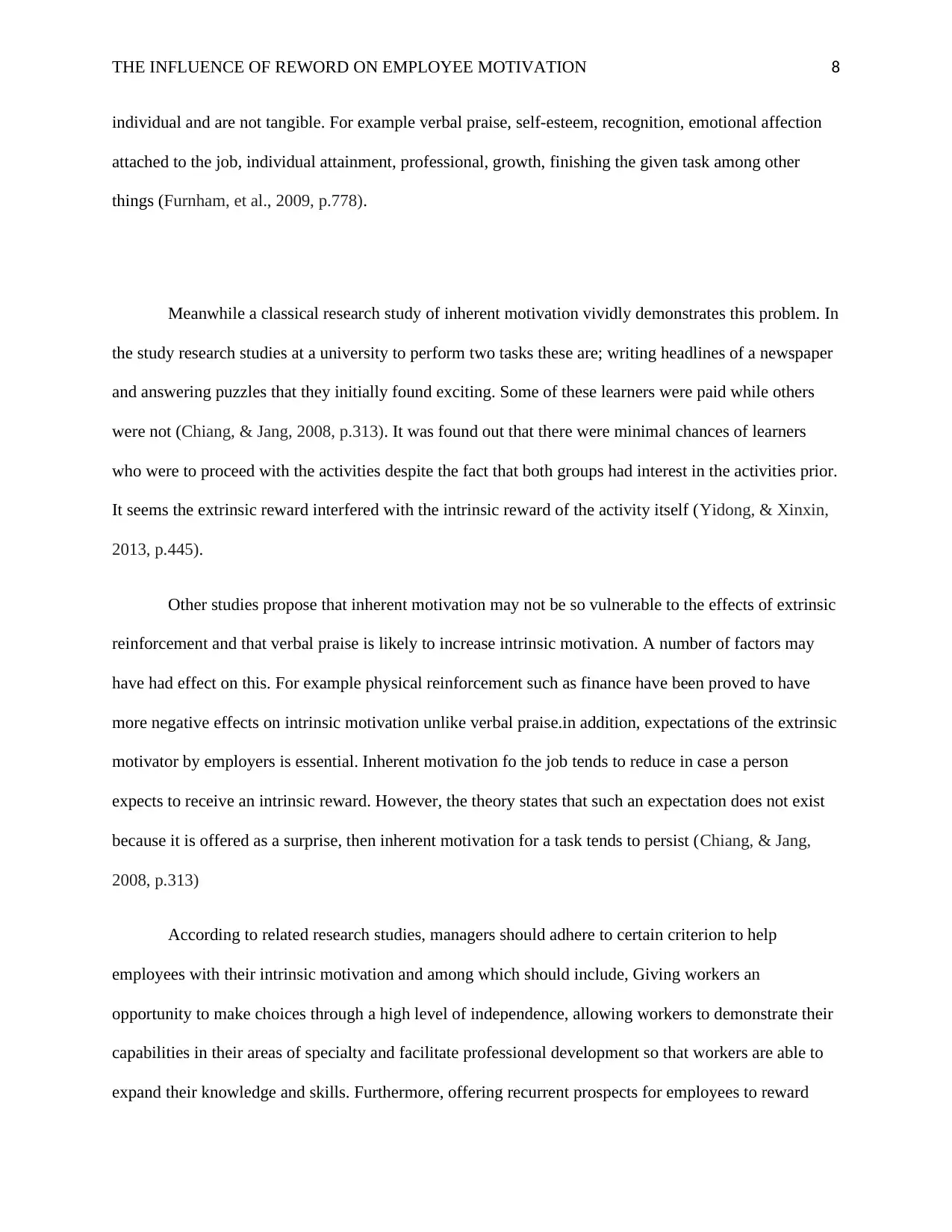
THE INFLUENCE OF REWORD ON EMPLOYEE MOTIVATION 8
individual and are not tangible. For example verbal praise, self-esteem, recognition, emotional affection
attached to the job, individual attainment, professional, growth, finishing the given task among other
things (Furnham, et al., 2009, p.778).
Meanwhile a classical research study of inherent motivation vividly demonstrates this problem. In
the study research studies at a university to perform two tasks these are; writing headlines of a newspaper
and answering puzzles that they initially found exciting. Some of these learners were paid while others
were not (Chiang, & Jang, 2008, p.313). It was found out that there were minimal chances of learners
who were to proceed with the activities despite the fact that both groups had interest in the activities prior.
It seems the extrinsic reward interfered with the intrinsic reward of the activity itself (Yidong, & Xinxin,
2013, p.445).
Other studies propose that inherent motivation may not be so vulnerable to the effects of extrinsic
reinforcement and that verbal praise is likely to increase intrinsic motivation. A number of factors may
have had effect on this. For example physical reinforcement such as finance have been proved to have
more negative effects on intrinsic motivation unlike verbal praise.in addition, expectations of the extrinsic
motivator by employers is essential. Inherent motivation fo the job tends to reduce in case a person
expects to receive an intrinsic reward. However, the theory states that such an expectation does not exist
because it is offered as a surprise, then inherent motivation for a task tends to persist (Chiang, & Jang,
2008, p.313)
According to related research studies, managers should adhere to certain criterion to help
employees with their intrinsic motivation and among which should include, Giving workers an
opportunity to make choices through a high level of independence, allowing workers to demonstrate their
capabilities in their areas of specialty and facilitate professional development so that workers are able to
expand their knowledge and skills. Furthermore, offering recurrent prospects for employees to reward
individual and are not tangible. For example verbal praise, self-esteem, recognition, emotional affection
attached to the job, individual attainment, professional, growth, finishing the given task among other
things (Furnham, et al., 2009, p.778).
Meanwhile a classical research study of inherent motivation vividly demonstrates this problem. In
the study research studies at a university to perform two tasks these are; writing headlines of a newspaper
and answering puzzles that they initially found exciting. Some of these learners were paid while others
were not (Chiang, & Jang, 2008, p.313). It was found out that there were minimal chances of learners
who were to proceed with the activities despite the fact that both groups had interest in the activities prior.
It seems the extrinsic reward interfered with the intrinsic reward of the activity itself (Yidong, & Xinxin,
2013, p.445).
Other studies propose that inherent motivation may not be so vulnerable to the effects of extrinsic
reinforcement and that verbal praise is likely to increase intrinsic motivation. A number of factors may
have had effect on this. For example physical reinforcement such as finance have been proved to have
more negative effects on intrinsic motivation unlike verbal praise.in addition, expectations of the extrinsic
motivator by employers is essential. Inherent motivation fo the job tends to reduce in case a person
expects to receive an intrinsic reward. However, the theory states that such an expectation does not exist
because it is offered as a surprise, then inherent motivation for a task tends to persist (Chiang, & Jang,
2008, p.313)
According to related research studies, managers should adhere to certain criterion to help
employees with their intrinsic motivation and among which should include, Giving workers an
opportunity to make choices through a high level of independence, allowing workers to demonstrate their
capabilities in their areas of specialty and facilitate professional development so that workers are able to
expand their knowledge and skills. Furthermore, offering recurrent prospects for employees to reward
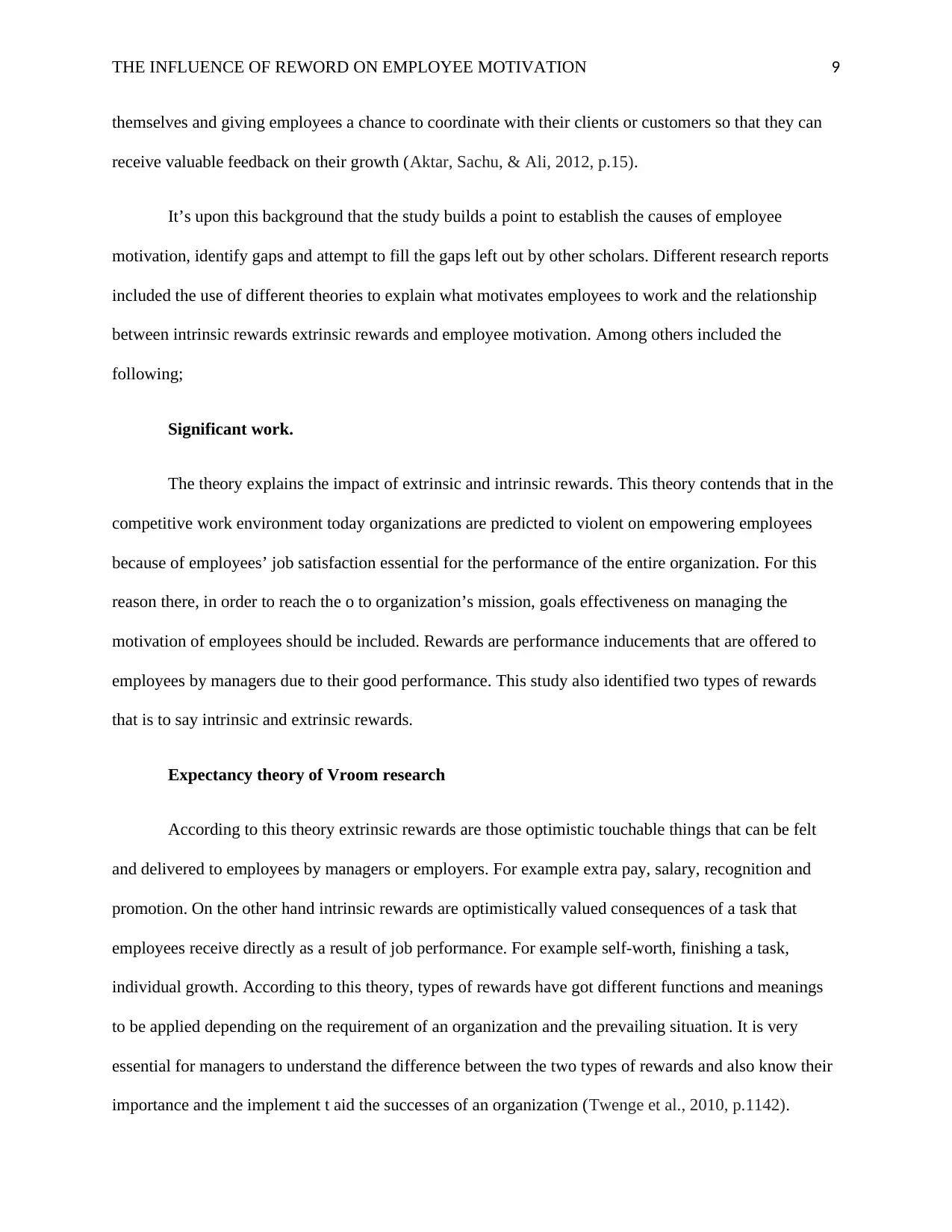
THE INFLUENCE OF REWORD ON EMPLOYEE MOTIVATION 9
themselves and giving employees a chance to coordinate with their clients or customers so that they can
receive valuable feedback on their growth (Aktar, Sachu, & Ali, 2012, p.15).
It’s upon this background that the study builds a point to establish the causes of employee
motivation, identify gaps and attempt to fill the gaps left out by other scholars. Different research reports
included the use of different theories to explain what motivates employees to work and the relationship
between intrinsic rewards extrinsic rewards and employee motivation. Among others included the
following;
Significant work.
The theory explains the impact of extrinsic and intrinsic rewards. This theory contends that in the
competitive work environment today organizations are predicted to violent on empowering employees
because of employees’ job satisfaction essential for the performance of the entire organization. For this
reason there, in order to reach the o to organization’s mission, goals effectiveness on managing the
motivation of employees should be included. Rewards are performance inducements that are offered to
employees by managers due to their good performance. This study also identified two types of rewards
that is to say intrinsic and extrinsic rewards.
Expectancy theory of Vroom research
According to this theory extrinsic rewards are those optimistic touchable things that can be felt
and delivered to employees by managers or employers. For example extra pay, salary, recognition and
promotion. On the other hand intrinsic rewards are optimistically valued consequences of a task that
employees receive directly as a result of job performance. For example self-worth, finishing a task,
individual growth. According to this theory, types of rewards have got different functions and meanings
to be applied depending on the requirement of an organization and the prevailing situation. It is very
essential for managers to understand the difference between the two types of rewards and also know their
importance and the implement t aid the successes of an organization (Twenge et al., 2010, p.1142).
themselves and giving employees a chance to coordinate with their clients or customers so that they can
receive valuable feedback on their growth (Aktar, Sachu, & Ali, 2012, p.15).
It’s upon this background that the study builds a point to establish the causes of employee
motivation, identify gaps and attempt to fill the gaps left out by other scholars. Different research reports
included the use of different theories to explain what motivates employees to work and the relationship
between intrinsic rewards extrinsic rewards and employee motivation. Among others included the
following;
Significant work.
The theory explains the impact of extrinsic and intrinsic rewards. This theory contends that in the
competitive work environment today organizations are predicted to violent on empowering employees
because of employees’ job satisfaction essential for the performance of the entire organization. For this
reason there, in order to reach the o to organization’s mission, goals effectiveness on managing the
motivation of employees should be included. Rewards are performance inducements that are offered to
employees by managers due to their good performance. This study also identified two types of rewards
that is to say intrinsic and extrinsic rewards.
Expectancy theory of Vroom research
According to this theory extrinsic rewards are those optimistic touchable things that can be felt
and delivered to employees by managers or employers. For example extra pay, salary, recognition and
promotion. On the other hand intrinsic rewards are optimistically valued consequences of a task that
employees receive directly as a result of job performance. For example self-worth, finishing a task,
individual growth. According to this theory, types of rewards have got different functions and meanings
to be applied depending on the requirement of an organization and the prevailing situation. It is very
essential for managers to understand the difference between the two types of rewards and also know their
importance and the implement t aid the successes of an organization (Twenge et al., 2010, p.1142).
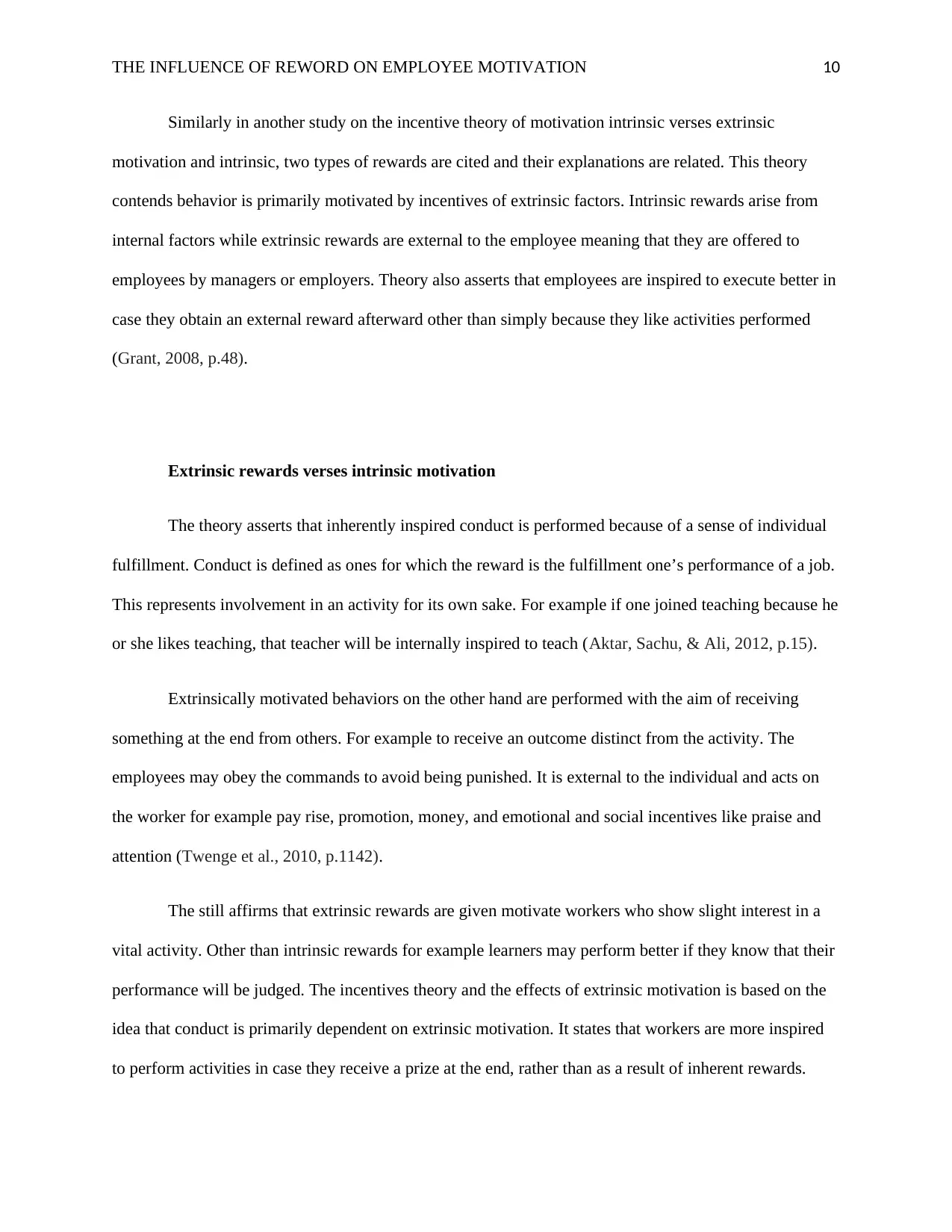
THE INFLUENCE OF REWORD ON EMPLOYEE MOTIVATION 10
Similarly in another study on the incentive theory of motivation intrinsic verses extrinsic
motivation and intrinsic, two types of rewards are cited and their explanations are related. This theory
contends behavior is primarily motivated by incentives of extrinsic factors. Intrinsic rewards arise from
internal factors while extrinsic rewards are external to the employee meaning that they are offered to
employees by managers or employers. Theory also asserts that employees are inspired to execute better in
case they obtain an external reward afterward other than simply because they like activities performed
(Grant, 2008, p.48).
Extrinsic rewards verses intrinsic motivation
The theory asserts that inherently inspired conduct is performed because of a sense of individual
fulfillment. Conduct is defined as ones for which the reward is the fulfillment one’s performance of a job.
This represents involvement in an activity for its own sake. For example if one joined teaching because he
or she likes teaching, that teacher will be internally inspired to teach (Aktar, Sachu, & Ali, 2012, p.15).
Extrinsically motivated behaviors on the other hand are performed with the aim of receiving
something at the end from others. For example to receive an outcome distinct from the activity. The
employees may obey the commands to avoid being punished. It is external to the individual and acts on
the worker for example pay rise, promotion, money, and emotional and social incentives like praise and
attention (Twenge et al., 2010, p.1142).
The still affirms that extrinsic rewards are given motivate workers who show slight interest in a
vital activity. Other than intrinsic rewards for example learners may perform better if they know that their
performance will be judged. The incentives theory and the effects of extrinsic motivation is based on the
idea that conduct is primarily dependent on extrinsic motivation. It states that workers are more inspired
to perform activities in case they receive a prize at the end, rather than as a result of inherent rewards.
Similarly in another study on the incentive theory of motivation intrinsic verses extrinsic
motivation and intrinsic, two types of rewards are cited and their explanations are related. This theory
contends behavior is primarily motivated by incentives of extrinsic factors. Intrinsic rewards arise from
internal factors while extrinsic rewards are external to the employee meaning that they are offered to
employees by managers or employers. Theory also asserts that employees are inspired to execute better in
case they obtain an external reward afterward other than simply because they like activities performed
(Grant, 2008, p.48).
Extrinsic rewards verses intrinsic motivation
The theory asserts that inherently inspired conduct is performed because of a sense of individual
fulfillment. Conduct is defined as ones for which the reward is the fulfillment one’s performance of a job.
This represents involvement in an activity for its own sake. For example if one joined teaching because he
or she likes teaching, that teacher will be internally inspired to teach (Aktar, Sachu, & Ali, 2012, p.15).
Extrinsically motivated behaviors on the other hand are performed with the aim of receiving
something at the end from others. For example to receive an outcome distinct from the activity. The
employees may obey the commands to avoid being punished. It is external to the individual and acts on
the worker for example pay rise, promotion, money, and emotional and social incentives like praise and
attention (Twenge et al., 2010, p.1142).
The still affirms that extrinsic rewards are given motivate workers who show slight interest in a
vital activity. Other than intrinsic rewards for example learners may perform better if they know that their
performance will be judged. The incentives theory and the effects of extrinsic motivation is based on the
idea that conduct is primarily dependent on extrinsic motivation. It states that workers are more inspired
to perform activities in case they receive a prize at the end, rather than as a result of inherent rewards.
Secure Best Marks with AI Grader
Need help grading? Try our AI Grader for instant feedback on your assignments.
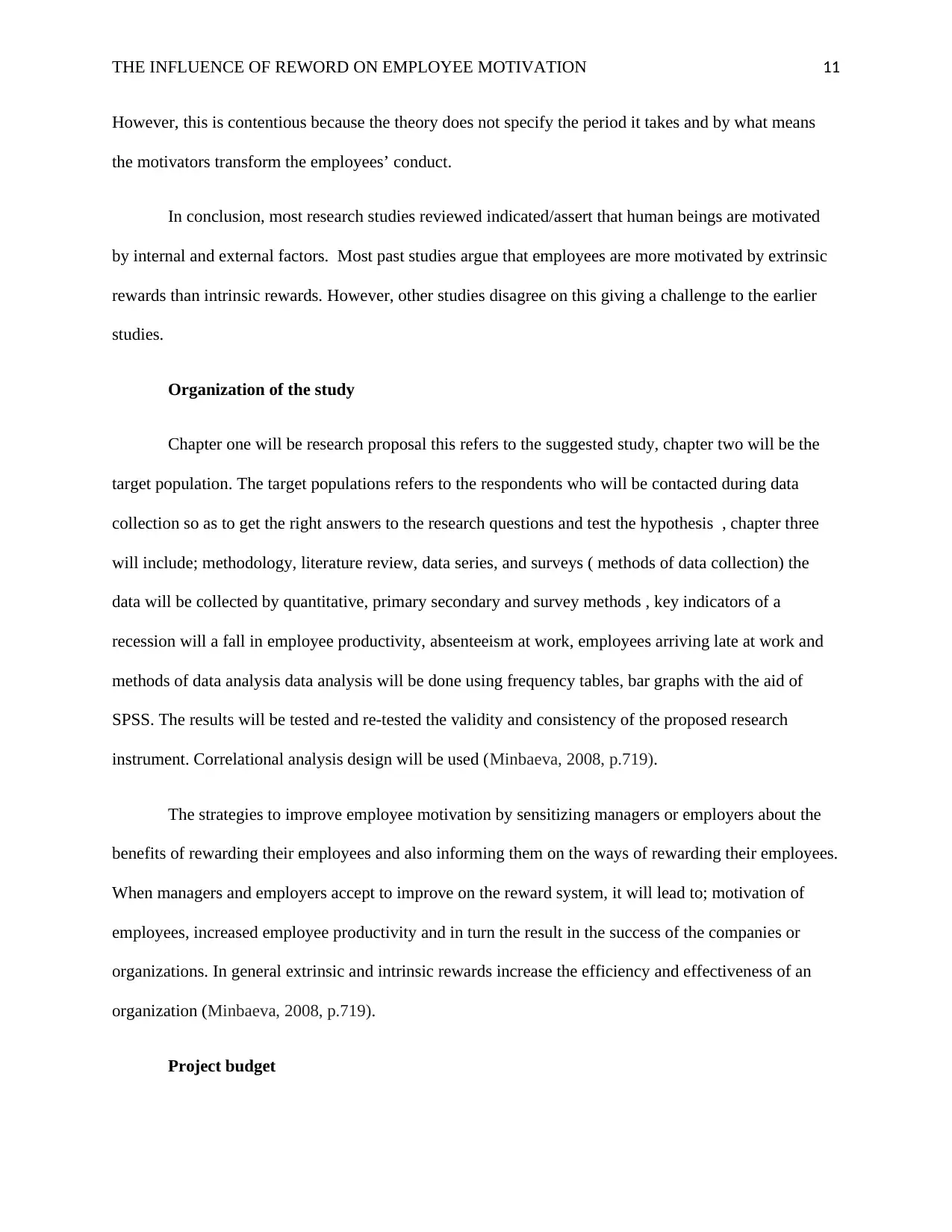
THE INFLUENCE OF REWORD ON EMPLOYEE MOTIVATION 11
However, this is contentious because the theory does not specify the period it takes and by what means
the motivators transform the employees’ conduct.
In conclusion, most research studies reviewed indicated/assert that human beings are motivated
by internal and external factors. Most past studies argue that employees are more motivated by extrinsic
rewards than intrinsic rewards. However, other studies disagree on this giving a challenge to the earlier
studies.
Organization of the study
Chapter one will be research proposal this refers to the suggested study, chapter two will be the
target population. The target populations refers to the respondents who will be contacted during data
collection so as to get the right answers to the research questions and test the hypothesis , chapter three
will include; methodology, literature review, data series, and surveys ( methods of data collection) the
data will be collected by quantitative, primary secondary and survey methods , key indicators of a
recession will a fall in employee productivity, absenteeism at work, employees arriving late at work and
methods of data analysis data analysis will be done using frequency tables, bar graphs with the aid of
SPSS. The results will be tested and re-tested the validity and consistency of the proposed research
instrument. Correlational analysis design will be used (Minbaeva, 2008, p.719).
The strategies to improve employee motivation by sensitizing managers or employers about the
benefits of rewarding their employees and also informing them on the ways of rewarding their employees.
When managers and employers accept to improve on the reward system, it will lead to; motivation of
employees, increased employee productivity and in turn the result in the success of the companies or
organizations. In general extrinsic and intrinsic rewards increase the efficiency and effectiveness of an
organization (Minbaeva, 2008, p.719).
Project budget
However, this is contentious because the theory does not specify the period it takes and by what means
the motivators transform the employees’ conduct.
In conclusion, most research studies reviewed indicated/assert that human beings are motivated
by internal and external factors. Most past studies argue that employees are more motivated by extrinsic
rewards than intrinsic rewards. However, other studies disagree on this giving a challenge to the earlier
studies.
Organization of the study
Chapter one will be research proposal this refers to the suggested study, chapter two will be the
target population. The target populations refers to the respondents who will be contacted during data
collection so as to get the right answers to the research questions and test the hypothesis , chapter three
will include; methodology, literature review, data series, and surveys ( methods of data collection) the
data will be collected by quantitative, primary secondary and survey methods , key indicators of a
recession will a fall in employee productivity, absenteeism at work, employees arriving late at work and
methods of data analysis data analysis will be done using frequency tables, bar graphs with the aid of
SPSS. The results will be tested and re-tested the validity and consistency of the proposed research
instrument. Correlational analysis design will be used (Minbaeva, 2008, p.719).
The strategies to improve employee motivation by sensitizing managers or employers about the
benefits of rewarding their employees and also informing them on the ways of rewarding their employees.
When managers and employers accept to improve on the reward system, it will lead to; motivation of
employees, increased employee productivity and in turn the result in the success of the companies or
organizations. In general extrinsic and intrinsic rewards increase the efficiency and effectiveness of an
organization (Minbaeva, 2008, p.719).
Project budget
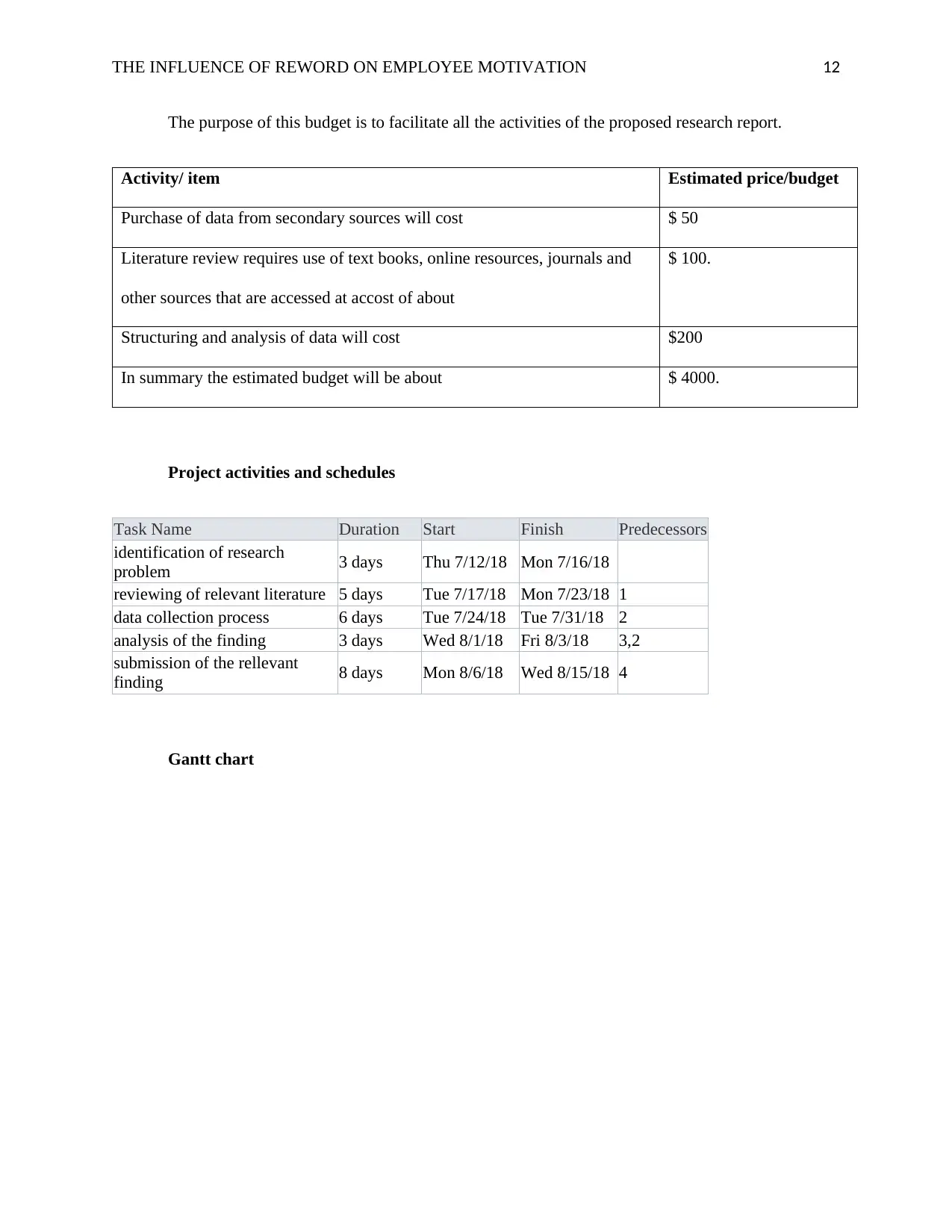
THE INFLUENCE OF REWORD ON EMPLOYEE MOTIVATION 12
The purpose of this budget is to facilitate all the activities of the proposed research report.
Activity/ item Estimated price/budget
Purchase of data from secondary sources will cost $ 50
Literature review requires use of text books, online resources, journals and
other sources that are accessed at accost of about
$ 100.
Structuring and analysis of data will cost $200
In summary the estimated budget will be about $ 4000.
Project activities and schedules
Task Name Duration Start Finish Predecessors
identification of research
problem 3 days Thu 7/12/18 Mon 7/16/18
reviewing of relevant literature 5 days Tue 7/17/18 Mon 7/23/18 1
data collection process 6 days Tue 7/24/18 Tue 7/31/18 2
analysis of the finding 3 days Wed 8/1/18 Fri 8/3/18 3,2
submission of the rellevant
finding 8 days Mon 8/6/18 Wed 8/15/18 4
Gantt chart
The purpose of this budget is to facilitate all the activities of the proposed research report.
Activity/ item Estimated price/budget
Purchase of data from secondary sources will cost $ 50
Literature review requires use of text books, online resources, journals and
other sources that are accessed at accost of about
$ 100.
Structuring and analysis of data will cost $200
In summary the estimated budget will be about $ 4000.
Project activities and schedules
Task Name Duration Start Finish Predecessors
identification of research
problem 3 days Thu 7/12/18 Mon 7/16/18
reviewing of relevant literature 5 days Tue 7/17/18 Mon 7/23/18 1
data collection process 6 days Tue 7/24/18 Tue 7/31/18 2
analysis of the finding 3 days Wed 8/1/18 Fri 8/3/18 3,2
submission of the rellevant
finding 8 days Mon 8/6/18 Wed 8/15/18 4
Gantt chart
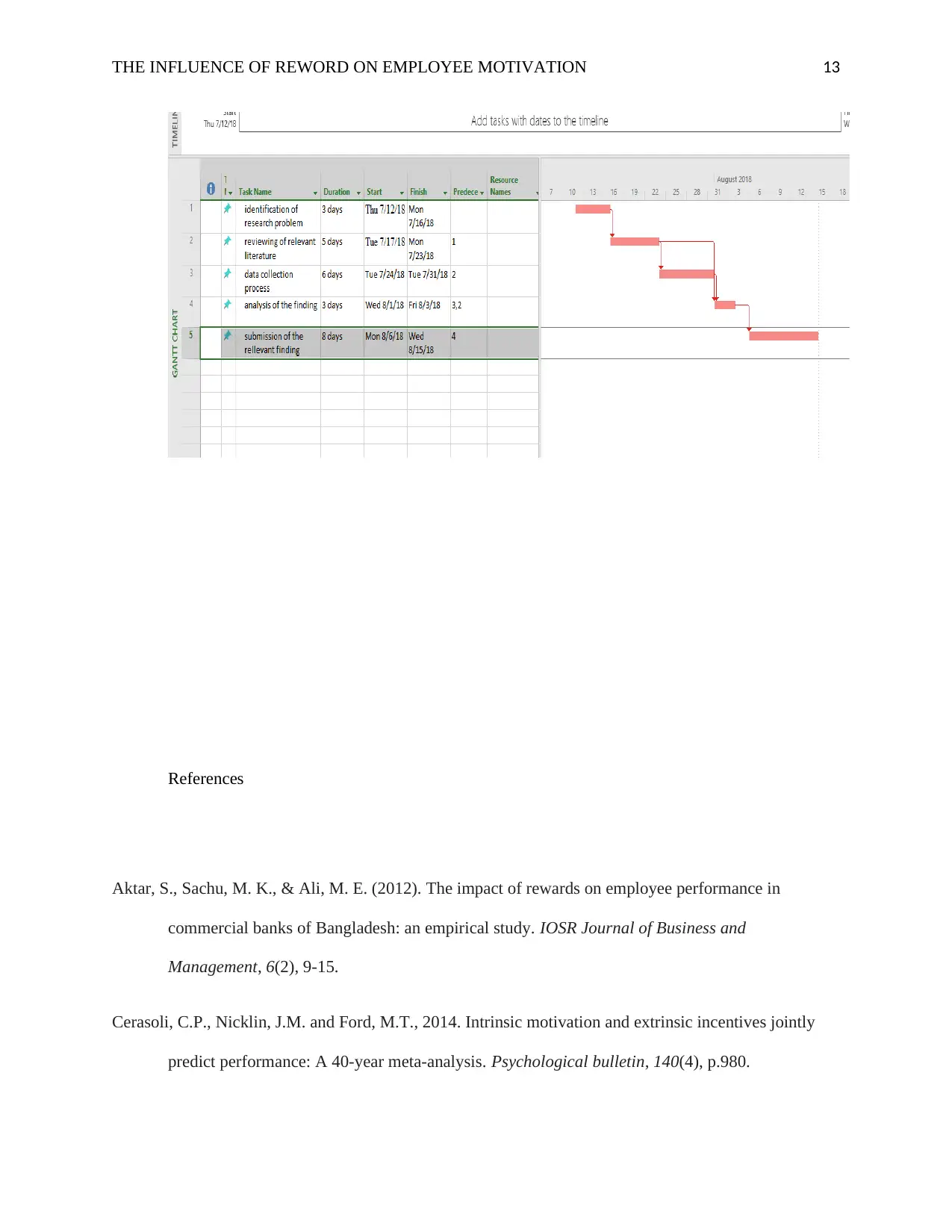
THE INFLUENCE OF REWORD ON EMPLOYEE MOTIVATION 13
References
Aktar, S., Sachu, M. K., & Ali, M. E. (2012). The impact of rewards on employee performance in
commercial banks of Bangladesh: an empirical study. IOSR Journal of Business and
Management, 6(2), 9-15.
Cerasoli, C.P., Nicklin, J.M. and Ford, M.T., 2014. Intrinsic motivation and extrinsic incentives jointly
predict performance: A 40-year meta-analysis. Psychological bulletin, 140(4), p.980.
References
Aktar, S., Sachu, M. K., & Ali, M. E. (2012). The impact of rewards on employee performance in
commercial banks of Bangladesh: an empirical study. IOSR Journal of Business and
Management, 6(2), 9-15.
Cerasoli, C.P., Nicklin, J.M. and Ford, M.T., 2014. Intrinsic motivation and extrinsic incentives jointly
predict performance: A 40-year meta-analysis. Psychological bulletin, 140(4), p.980.
Paraphrase This Document
Need a fresh take? Get an instant paraphrase of this document with our AI Paraphraser
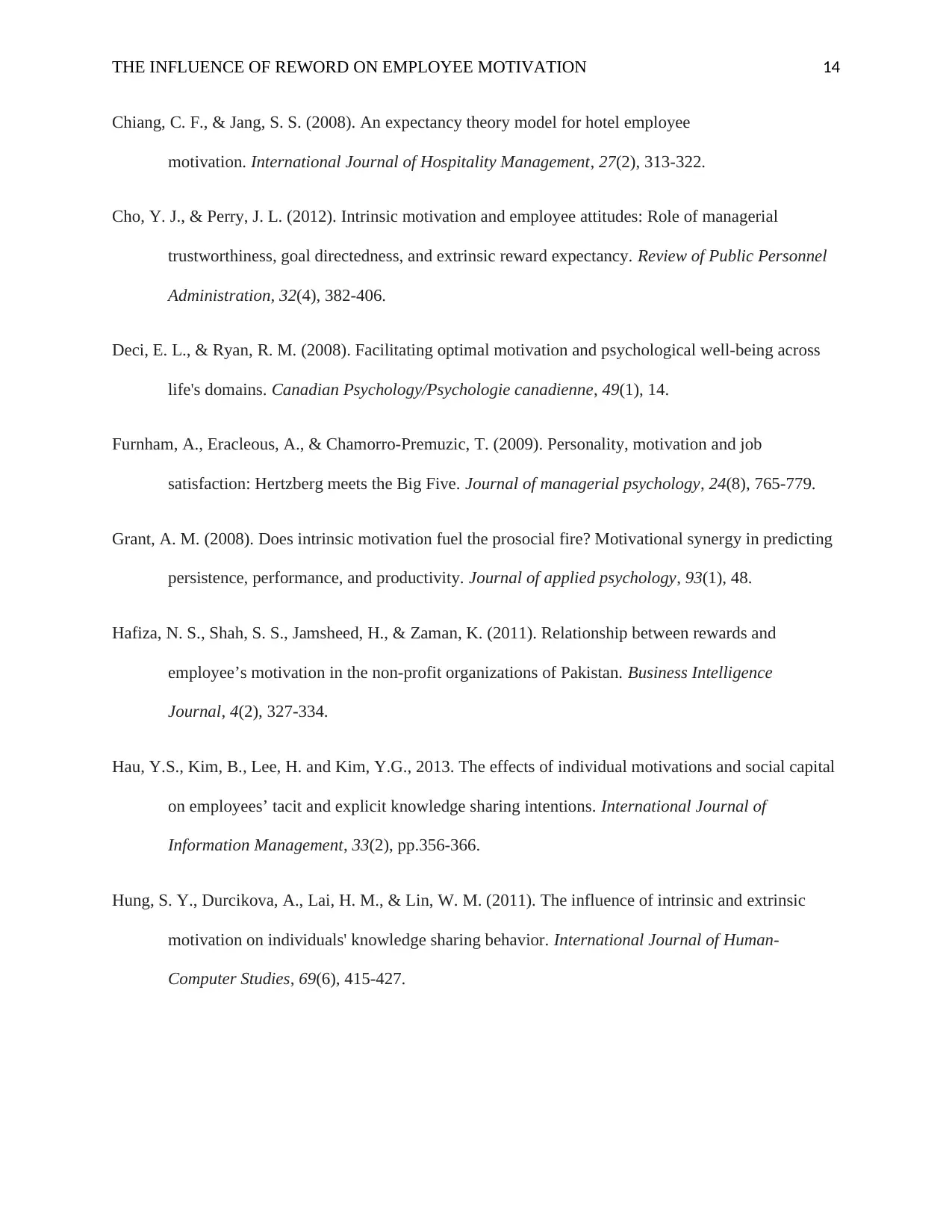
THE INFLUENCE OF REWORD ON EMPLOYEE MOTIVATION 14
Chiang, C. F., & Jang, S. S. (2008). An expectancy theory model for hotel employee
motivation. International Journal of Hospitality Management, 27(2), 313-322.
Cho, Y. J., & Perry, J. L. (2012). Intrinsic motivation and employee attitudes: Role of managerial
trustworthiness, goal directedness, and extrinsic reward expectancy. Review of Public Personnel
Administration, 32(4), 382-406.
Deci, E. L., & Ryan, R. M. (2008). Facilitating optimal motivation and psychological well-being across
life's domains. Canadian Psychology/Psychologie canadienne, 49(1), 14.
Furnham, A., Eracleous, A., & Chamorro-Premuzic, T. (2009). Personality, motivation and job
satisfaction: Hertzberg meets the Big Five. Journal of managerial psychology, 24(8), 765-779.
Grant, A. M. (2008). Does intrinsic motivation fuel the prosocial fire? Motivational synergy in predicting
persistence, performance, and productivity. Journal of applied psychology, 93(1), 48.
Hafiza, N. S., Shah, S. S., Jamsheed, H., & Zaman, K. (2011). Relationship between rewards and
employee’s motivation in the non-profit organizations of Pakistan. Business Intelligence
Journal, 4(2), 327-334.
Hau, Y.S., Kim, B., Lee, H. and Kim, Y.G., 2013. The effects of individual motivations and social capital
on employees’ tacit and explicit knowledge sharing intentions. International Journal of
Information Management, 33(2), pp.356-366.
Hung, S. Y., Durcikova, A., Lai, H. M., & Lin, W. M. (2011). The influence of intrinsic and extrinsic
motivation on individuals' knowledge sharing behavior. International Journal of Human-
Computer Studies, 69(6), 415-427.
Chiang, C. F., & Jang, S. S. (2008). An expectancy theory model for hotel employee
motivation. International Journal of Hospitality Management, 27(2), 313-322.
Cho, Y. J., & Perry, J. L. (2012). Intrinsic motivation and employee attitudes: Role of managerial
trustworthiness, goal directedness, and extrinsic reward expectancy. Review of Public Personnel
Administration, 32(4), 382-406.
Deci, E. L., & Ryan, R. M. (2008). Facilitating optimal motivation and psychological well-being across
life's domains. Canadian Psychology/Psychologie canadienne, 49(1), 14.
Furnham, A., Eracleous, A., & Chamorro-Premuzic, T. (2009). Personality, motivation and job
satisfaction: Hertzberg meets the Big Five. Journal of managerial psychology, 24(8), 765-779.
Grant, A. M. (2008). Does intrinsic motivation fuel the prosocial fire? Motivational synergy in predicting
persistence, performance, and productivity. Journal of applied psychology, 93(1), 48.
Hafiza, N. S., Shah, S. S., Jamsheed, H., & Zaman, K. (2011). Relationship between rewards and
employee’s motivation in the non-profit organizations of Pakistan. Business Intelligence
Journal, 4(2), 327-334.
Hau, Y.S., Kim, B., Lee, H. and Kim, Y.G., 2013. The effects of individual motivations and social capital
on employees’ tacit and explicit knowledge sharing intentions. International Journal of
Information Management, 33(2), pp.356-366.
Hung, S. Y., Durcikova, A., Lai, H. M., & Lin, W. M. (2011). The influence of intrinsic and extrinsic
motivation on individuals' knowledge sharing behavior. International Journal of Human-
Computer Studies, 69(6), 415-427.
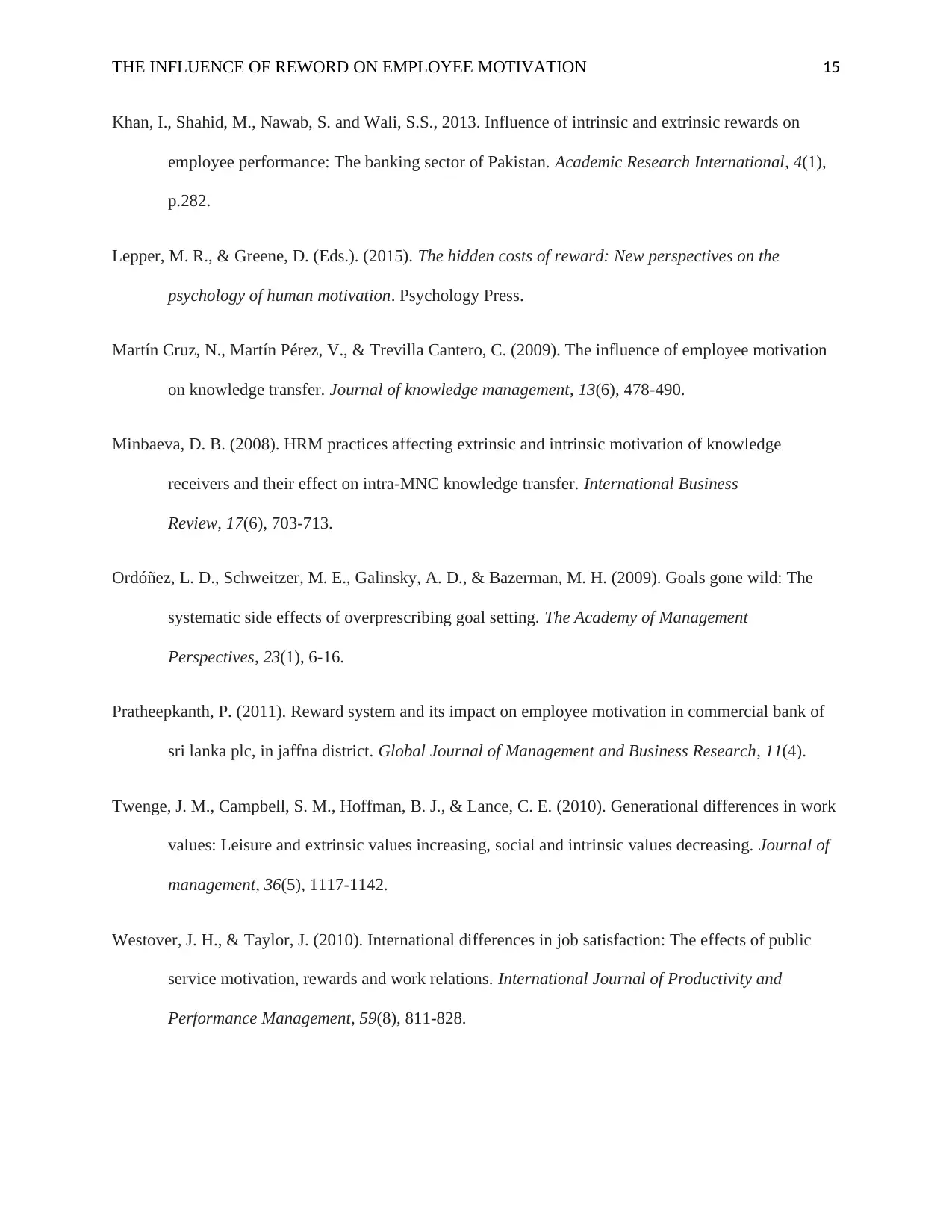
THE INFLUENCE OF REWORD ON EMPLOYEE MOTIVATION 15
Khan, I., Shahid, M., Nawab, S. and Wali, S.S., 2013. Influence of intrinsic and extrinsic rewards on
employee performance: The banking sector of Pakistan. Academic Research International, 4(1),
p.282.
Lepper, M. R., & Greene, D. (Eds.). (2015). The hidden costs of reward: New perspectives on the
psychology of human motivation. Psychology Press.
Martín Cruz, N., Martín Pérez, V., & Trevilla Cantero, C. (2009). The influence of employee motivation
on knowledge transfer. Journal of knowledge management, 13(6), 478-490.
Minbaeva, D. B. (2008). HRM practices affecting extrinsic and intrinsic motivation of knowledge
receivers and their effect on intra-MNC knowledge transfer. International Business
Review, 17(6), 703-713.
Ordóñez, L. D., Schweitzer, M. E., Galinsky, A. D., & Bazerman, M. H. (2009). Goals gone wild: The
systematic side effects of overprescribing goal setting. The Academy of Management
Perspectives, 23(1), 6-16.
Pratheepkanth, P. (2011). Reward system and its impact on employee motivation in commercial bank of
sri lanka plc, in jaffna district. Global Journal of Management and Business Research, 11(4).
Twenge, J. M., Campbell, S. M., Hoffman, B. J., & Lance, C. E. (2010). Generational differences in work
values: Leisure and extrinsic values increasing, social and intrinsic values decreasing. Journal of
management, 36(5), 1117-1142.
Westover, J. H., & Taylor, J. (2010). International differences in job satisfaction: The effects of public
service motivation, rewards and work relations. International Journal of Productivity and
Performance Management, 59(8), 811-828.
Khan, I., Shahid, M., Nawab, S. and Wali, S.S., 2013. Influence of intrinsic and extrinsic rewards on
employee performance: The banking sector of Pakistan. Academic Research International, 4(1),
p.282.
Lepper, M. R., & Greene, D. (Eds.). (2015). The hidden costs of reward: New perspectives on the
psychology of human motivation. Psychology Press.
Martín Cruz, N., Martín Pérez, V., & Trevilla Cantero, C. (2009). The influence of employee motivation
on knowledge transfer. Journal of knowledge management, 13(6), 478-490.
Minbaeva, D. B. (2008). HRM practices affecting extrinsic and intrinsic motivation of knowledge
receivers and their effect on intra-MNC knowledge transfer. International Business
Review, 17(6), 703-713.
Ordóñez, L. D., Schweitzer, M. E., Galinsky, A. D., & Bazerman, M. H. (2009). Goals gone wild: The
systematic side effects of overprescribing goal setting. The Academy of Management
Perspectives, 23(1), 6-16.
Pratheepkanth, P. (2011). Reward system and its impact on employee motivation in commercial bank of
sri lanka plc, in jaffna district. Global Journal of Management and Business Research, 11(4).
Twenge, J. M., Campbell, S. M., Hoffman, B. J., & Lance, C. E. (2010). Generational differences in work
values: Leisure and extrinsic values increasing, social and intrinsic values decreasing. Journal of
management, 36(5), 1117-1142.
Westover, J. H., & Taylor, J. (2010). International differences in job satisfaction: The effects of public
service motivation, rewards and work relations. International Journal of Productivity and
Performance Management, 59(8), 811-828.
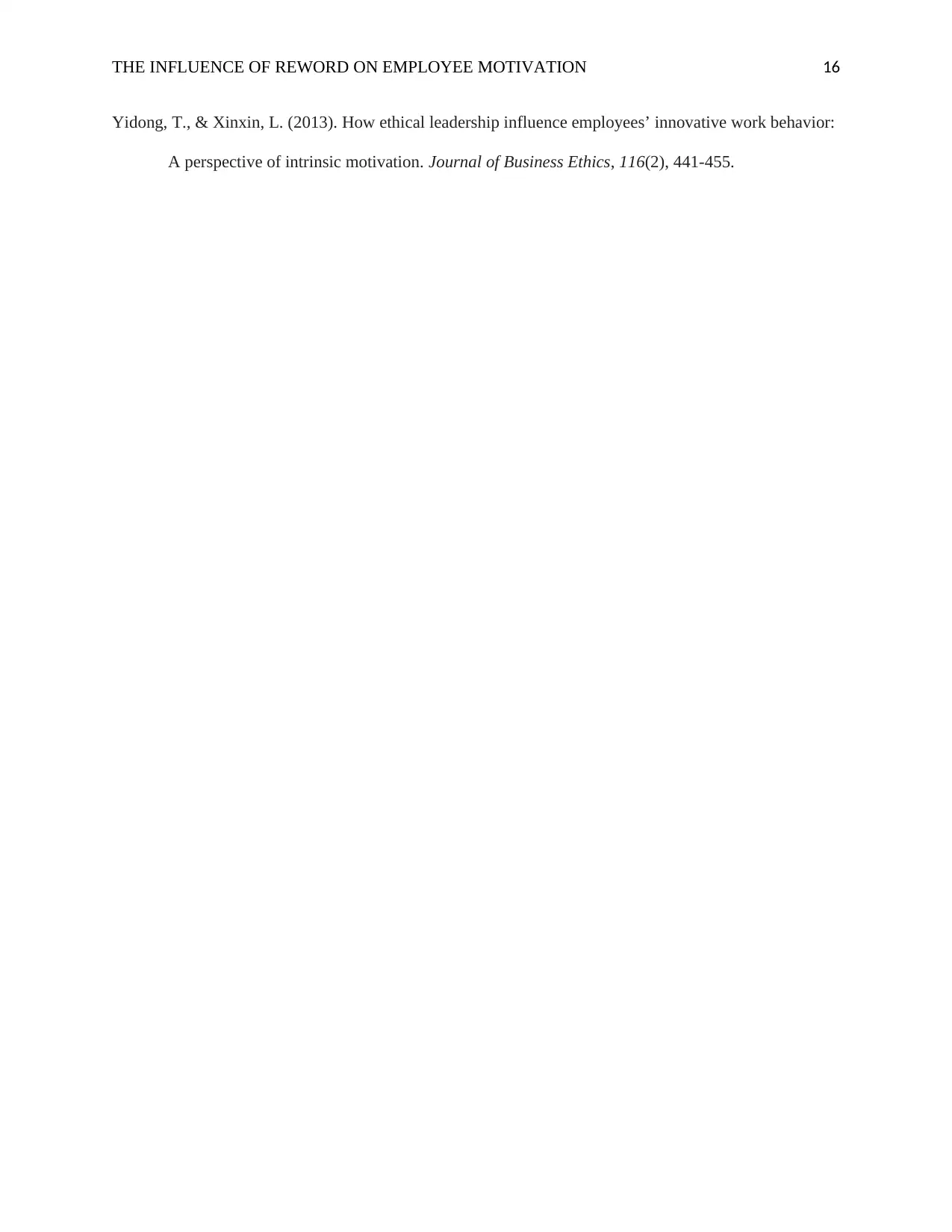
THE INFLUENCE OF REWORD ON EMPLOYEE MOTIVATION 16
Yidong, T., & Xinxin, L. (2013). How ethical leadership influence employees’ innovative work behavior:
A perspective of intrinsic motivation. Journal of Business Ethics, 116(2), 441-455.
Yidong, T., & Xinxin, L. (2013). How ethical leadership influence employees’ innovative work behavior:
A perspective of intrinsic motivation. Journal of Business Ethics, 116(2), 441-455.
1 out of 16
Related Documents
Your All-in-One AI-Powered Toolkit for Academic Success.
+13062052269
info@desklib.com
Available 24*7 on WhatsApp / Email
![[object Object]](/_next/static/media/star-bottom.7253800d.svg)
Unlock your academic potential
© 2024 | Zucol Services PVT LTD | All rights reserved.





